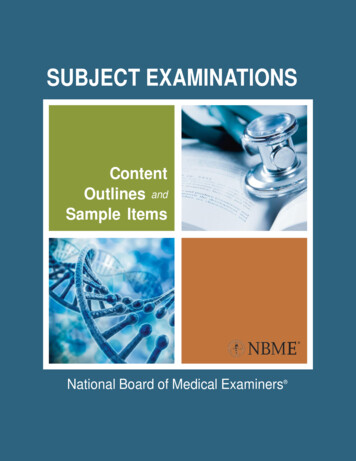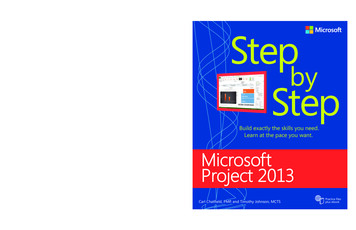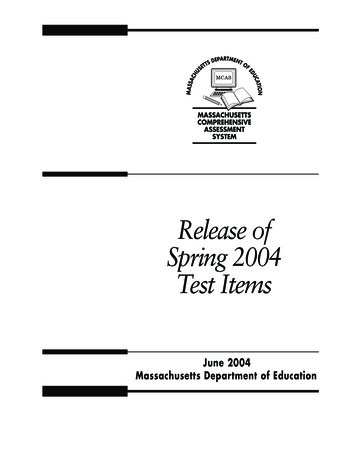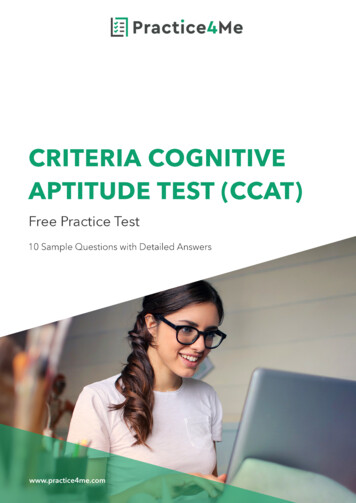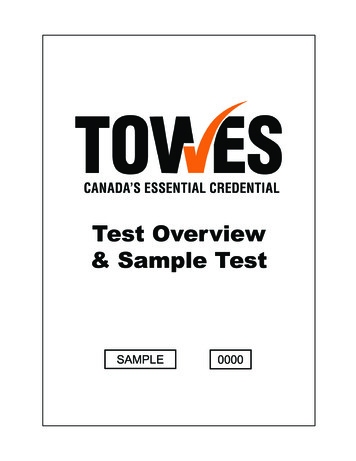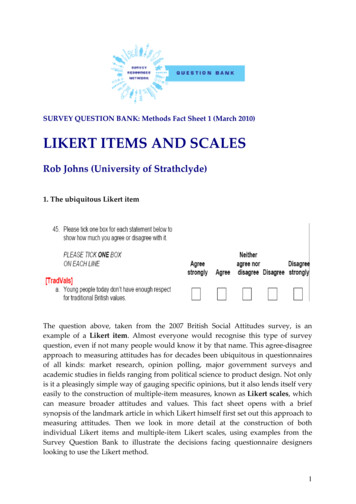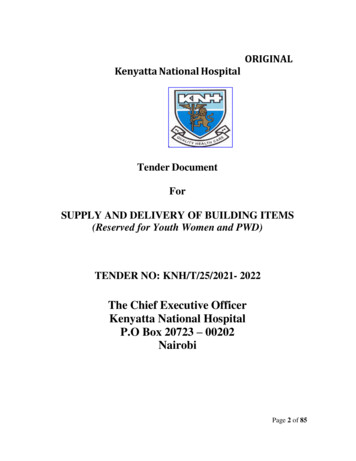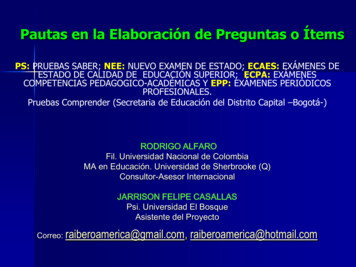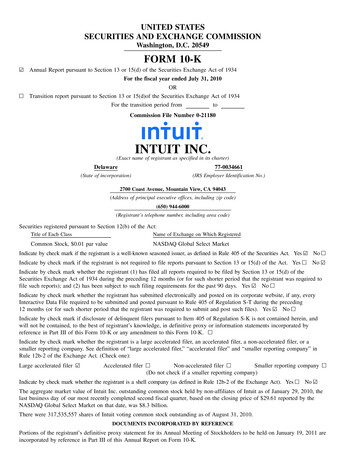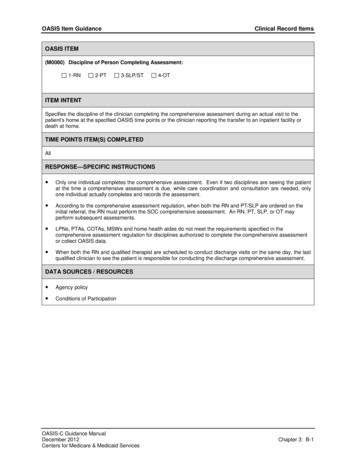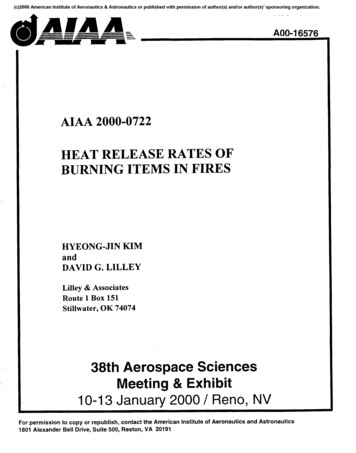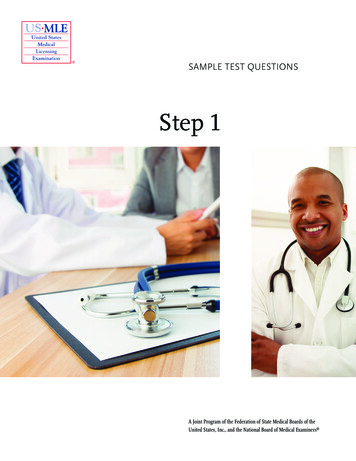
Transcription
SAMPLE TEST QUESTIONSStep 1A Joint Program of the Federation of State Medical Boards of theUnited States, Inc., and the National Board of Medical Examiners
This booklet was updated January 2020.Copyright 2020 by the Federation of State Medical Boards of the United States, Inc. (FSMB), and the National Board of Medical Examiners (NBME ). All rights reserved. Printed in the United States of America. The United States Medical Licensing Examination (USMLE ) is a joint program of the FSMB and the NBME.1
CONTENTSUSMLE Step 1 Test Question Formats 3Introduction to USMLE Step 1 Sample Test Questions . 4USMLE Laboratory Values . 5USMLE Step 1 Sample Test Questions . 8Answer Form for USMLE Step 1 Sample Test Questions . 48Answer Key for USMLE Step 1 Sample Test Questions . 492
USMLE STEP 1 TEST QUESTION FORMATSSingle-Item QuestionsA single patient-centered vignette is associated with one question followed by four or more response options.The response options are lettered (A, B, C, D, E). A portion of the questions require interpretation of graphicor pictorial materials. You are required to select the best answer to the question. Other options may bepartially correct, but there is only ONE BEST answer. This is the traditional, most frequently used multiplechoice question format on the examination.Strategies for Answering Single One-Best-Answer Test QuestionsThe following are strategies for answering one-best-answer items: Read each patient vignette and question carefully. It is important to understand what is being asked.Try to generate an answer and then look for it in the response option list.Alternatively, read each response option carefully, eliminating those that are clearly incorrect.Of the remaining options, select the one that is most correct.If unsure about an answer, it is better to guess since unanswered questions are automatically countedas wrong answers.Example ItemA 32-year-old woman with type 1 diabetes mellitus has had progressive renal failure during the past 2 years.She has not yet started dialysis. Examination shows no abnormalities. Her hemoglobin concentration is 9 g/dL,hematocrit is 28%, and mean corpuscular volume is 94 μm3. A blood smear shows normochromic, normocyticcells. Which of the following is the most likely cause?(A)(B)(C)(D)(E)Acute blood lossChronic lymphocytic leukemiaErythrocyte enzyme deficiencyErythropoietin pathic hemolysisPolycythemia veraSickle cell diseaseSideroblastic anemiaβ-Thalassemia trait(Answer: D)NOTE: Some item types that appear on the Step 1 examination are NOT depicted in the sample items providedin this booklet, eg, items with multimedia features, such as audio. Also, when additional item formats areadded to the exam, notice will be provided at the USMLE website: http://www.usmle.org. You must monitorthe website to stay informed about the types of items that occur in the exam, and you must practice with thedownloadable sample test items available on the USMLE website to be fully prepared for the examination.3
INTRODUCTION TO USMLE STEP 1 SAMPLE TEST QUESTIONSThe following pages include 119 sample test questions. Most of these questions are the same as those you caninstall on your computer from the USMLE website. Please note that reviewing the sample questions as theyappear on pages 8–47 is not a substitute for practicing with the test software. You should download and runthe Step 1 tutorial and practice test items that are provided on the USMLE website well before your test date.The sample materials available on the USMLE website include an additional item with associated audiofindings that does not appear in this booklet. You should become familiar with this item format that will beused in the actual examination.Although the sample questions exemplify content on the Step 1 examination overall, they may not reflect thecontent coverage on individual examinations. In the actual examination, questions will be presented inrandom order; they will not be grouped according to specific content. The questions will be presented one ata time in a format designed for easy on-screen reading, including use of the USMLE Laboratory Values table(included here on pages 5–7) and some pictorials. Photographs, charts, and x-rays in this booklet are not ofthe same quality as the pictorials used in the actual examination. In addition, you will be able to adjust thebrightness and contrast of pictorials on the computer screen.To take the following sample test questions as they would be timed in the actual examination, you shouldallow a maximum of 1 hour for each 40-item block, and a maximum of 58 minutes, 30 seconds, for the 39-itemblock, for a total of 2 hours, 58 minutes, 30 seconds. Please note that the third block has 39 items instead of40 because the multimedia item has been removed, and the recommended time to complete the block hasbeen adjusted accordingly. Please be aware that most examinees perceive the time pressure to be greaterduring an actual examination. All examinees are strongly encouraged to practice with the downloadableversion to become familiar with all item formats and exam timing. An answer form for recording answers isprovided on page 48. An answer key is provided on page 49. In the actual examination, answers will beselected on the screen; no answer form will be provided.4
USMLE Laboratory ValuesSERUMHepatic:Alanine aminotransferase (ALT)Aspartate aminotransferase (AST)Alkaline phosphataseAmylaseBilirubin, Total // DirectProteins, totalAlbuminGlobulinCoagulation:Partial thromboplastin time (PTT) (activated)Prothrombin time desGeneral Chemistry:Urea nitrogenCreatinineElectrolytes Sodium (Na ) Potassium (K )–Chloride (Cl )–Bicarbonate (HCO3 )GlucoseCalcium2 Magnesium (Mg )Phosphorus (inorganic)Iron Studies:FerritinIronTotal iron-binding capacityTransferrinReference RangeSI Reference Intervals10–40 U/L12–38 U/L25–100 U/L25–125 U/L0.1–1.0 mg/dL // 0.0–0.3 mg/dL6.0–7.8 g/dL3.5–5.5 g/dL2.3–3.5 g/dL10–40 U/L12–38 U/L25–100 U/L25–125 U/L2–17 μmol/L // 0–5 μmol/L60–78 g/L35–55 g/L23–35 g/L25–40 seconds11–15 seconds 250 ng/mL25–40 seconds11–15 seconds 1.4 nmol/LNormal: 200 mg/dLHigh: 240 mg/dL40–60 mg/dL 160 mg/dLNormal: 150 mg/dLBorderline: 151–199 mg/dL 5.2 mmol/L 6.2 mmol/L1.0–1.6 mmol/L 4.2 mmol/L 1.70 mmol/L1.71–2.25 mmol/L7–18 mg/dL0.6–1.2 mg/dL2.5–6.4 mmol/L53–106 μmol/L136–146 mEq/L3.5–5.0 mEq/L95–105 mEq/L22–28 mEq/LFasting: 70–100 mg/dL8.4–10.2 mg/dL1.5–2.0 mg/dL3.0–4.5 mg/dL136–146 mmol/L3.5–5.0 mmol/L95–105 mmol/L22–28 mmol/L3.8–5.6 mmol/L2.1–2.6 mmol/L0.75–1.0 mmol/L1.0–1.5 mmol/LMale: 20–250 ng/mLFemale: 10–120 ng/mLMale: 65–175 µg/dLFemale: 50–170 μg/dL250–400 µg/dL200–360 mg/dL20–250 μg/L10–120 μg/L11.6–31.3 μmol/L9.0–30.4 μmol/L44.8–71.6 μmol/L2.0–3.6 g/L5Continued on Next Page
USMLE Laboratory Values (continued)Reference RangeSI Reference IntervalsMale: 4–25 mIU/mLFemale: premenopause 4–30 mIU/mLmidcycle peak 10–90 mIU/mLpostmenopause 40–250 mIU/mLMale: 6–23 mIU/mLFemale: follicular phase 5–30 mIU/mLmidcycle 75–150 mIU/mLpostmenopause 30–200 mIU/mLFasting: 5 ng/mLProvocative stimuli: 7 ng/mLMale: 17 ng/mLFemale: 25 ng/mL0800 h: 5–23 μg/dL1600 h: 3–15 μg/dL2000 h: 50% of 0800 h0.4–4.0 μU/mL100–200 ng/dL25%–35%5–12 μg/dL0.9–1.7 ng/dL8%–30% of administered dose/24 h10–60 pg/mLMale: 3.0–10.0 mg/24 hFemale: 2.0–8.0 mg/24 hMale: 8–20 mg/24 hFemale: 6–15 mg/24 h 6% 4 mg/dL4–25 IU/L4–30 IU/L10–90 IU/L40–250 IU/L6–23 IU/L5–30 IU/L75–150 IU/L30–200 IU/L 5 μg/L 7 μg/L 17 μg/L 25 μg/L138–635 nmol/L82–413 nmol/LFraction of 0800 h: 0.500.4–4.0 mIU/L1.5–3.1 nmol/L0.25–0.3564–155 nmol/L12.0–21.9 pmol/L0.08–0.30/24 h10–60 ng/L8.2–27.6 μmol/24 h5.5–22.0 μmol/24 h28–70 μmol/24 h21–52 μmol/24 h 42 mmol/mol 0.62 mmol/L76–390 mg/dL0–380 IU/mL650–1500 mg/dL50–300 mg/dL0.76–3.90 g/L0–380 kIU/L6.5–15.0 g/L0.5–3.0 g/LMale: 25–90 U/LFemale: 10–70 U/L45–200 U/L275–295 mOsmol/kg H2O3.0–8.2 mg/dL25–90 U/L10–70 U/L45–200 U/L275–295 mOsmol/kg H2O0.18–0.48 mmol/LGASES, ARTERIAL BLOOD (ROOM AIR)PO 2PCO2pH75–105 mm Hg33–45 mm Hg7.35–7.4510.0–14.0 kPa4.4–5.9 kPa [H ] 36–44 nmol/LCEREBROSPINAL FLUIDCell countChlorideGamma globulinGlucosePressureProteins, total0–5/mm118–132 mEq/L3%–12% total proteins40–70 mg/dL70–180 mm H2O 40 mg/dLEndocrine:Follicle-stimulating hormoneLuteinizing hormoneGrowth hormone - arginine stimulationProlactin (hPRL)CortisolTSHTriiodothyronine (T3) (RIA)Triiodothyronine (T3) resin uptakeThyroxine (T4)Free T4123Thyroidal iodine ( I) uptakeIntact PTH17-Hydroxycorticosteroids17-Ketosteroids, totalHemoglobin A1cHemoglobin, plasmaImmunoglobulins:IgAIgEIgGIgMOther, serum:Creatine kinaseLactate dehydrogenaseOsmolalityUric acid3660–5 10 /L118–132 mmol/L0.03–0.122.2–3.9 mmol/L70–180 mm H2O 0.40 g/LContinued on Next Page
USMLE Laboratory Values (continued)HEMATOLOGICComplete Blood Count:HematocritHemoglobin, bloodMean corpuscular hemoglobin (MCH)Mean corpuscular hemoglobin conc. (MCHC)Mean corpuscular volume (MCV)VolumePlasmaRed cellLeukocyte count (WBC)Neutrophils, segmentedNeutrophils, let countOther, Hematologic:Reticulocyte countErythrocyte countErythrocyte sedimentation rate (Westergren)CD4 T-lymphocyte countTroponin IURINECalciumCreatinine clearanceOsmolalityOxalateProteins, totalBODY MASS INDEX (BMI)Reference RangeSI Reference IntervalsMale: 41%–53%Female: 36%–46%Male: 13.5–17.5 g/dLFemale: 12.0–16.0 g/dL25–35 pg/cell31%–36% Hb/cell380–100 μm0.41–0.530.36–0.46135–175 g/L120–160 g/L0.39–0.54 fmol/cell4.8–5.6 mmol Hb/L80–100 fLMale: 25–43 mL/kgFemale: 28–45 mL/kgMale: 20–36 mL/kgFemale: 19–31 0.043 L/kg0.028–0.045 L/kg0.020–0.036 L/kg0.019–0.031 L/kg94.5–11.0 10 25–0.330.03–0.079150–400 10 /L0.5%–1.5%3Male: 4.3–5.9 million/mm3Female: 3.5–5.5 million/mmMale: 0–15 mm/hFemale: 0–20 mm/h3 500/mm 0.04 ng/mL0.005–0.015124.3–5.9 10 /L123.5–5.5 10 /L0–15 mm/h0–20 mm/h9 0.5 10 /L 0.04 µg/L100–300 mg/24 hMale: 97–137 mL/minFemale: 88–128 mL/min50–1200 mOsmol/kg H2O8–40 μg/mL 150 mg/24 h2.5–7.5 mmol/24 h97–137 mL/min88–128 mL/min50–1200 mOsmol/kg H2O90–445 μmol/L 0.15 g/24 h2Adult: 19–25 kg/m7
USMLE STEP 1 SAMPLE TEST QUESTIONSBLOCK 1, ITEMS 1-401.A 67-year-old woman with congenital bicuspid aortic valve is admitted to the hospital because of a 2-day history offever and chills. Current medication is lisinopril. Temperature is 38.0 C (100.4 F), pulse is 90/min, respirations are20/min, and blood pressure is 110/70 mm Hg. Cardiac examination shows a grade 3/6 systolic murmur that is bestheard over the second right intercostal space. Blood culture grows viridans streptococci susceptible to penicillin. Inaddition to penicillin, an antibiotic synergistic to penicillin is administered that may help shorten the duration of thispatient's drug treatment. Which of the following is the most likely mechanism of action of this additional antibioticon bacteria?(A)(B)(C)(D)(E)2.A 12-year-old girl is brought to the physician because of a 2-month history of intermittent yellowing of the eyes andskin. Physical examination shows no abnormalities except for jaundice. Her serum total bilirubin concentration is3 mg/dL, with a direct component of 1 mg/dL. Serum studies show a haptoglobin concentration and AST and ALTactivities that are within the reference ranges. There is no evidence of injury or exposure to toxins. Which of thefollowing additional findings is most likely in this patient?(A)(B)(C)(D)(E)3.Binding to DNA-dependent RNA polymeraseBinding to the 30S ribosomal proteinCompetition with p-aminobenzoic acidInhibition of dihydrofolate reductaseInhibition of DNA gyraseDecreased activity of UDP glucuronosyltransferaseGallstonesIncreased hemolysisIncreased serum alkaline phosphatase activityIneffective erythropoiesisDuring an experiment, drug X is added to a muscle bath containing a strip of guinea pig intestinal smooth muscle.Agonists are added to the bath, and the resultant effects on muscle tension are shown in the cle Tension Before Drug X (g)6.011.34.1Muscle Tension After Drug X (g)6.118.54.2Which of the following types of drugs is most likely to produce effects most similar to those of drug X?(A)(B)(C)(D)(E)α1-Adrenergic antagonistβ-Adrenergic antagonistCholinesterase inhibitorMonoamine oxidase inhibitorMuscarinic antagonist8
4.A 30-year-old woman, gravida 2, para 0, aborta 1, at 28 weeks' gestation comes to the office for a prenatal visit. Shehas had one previous pregnancy resulting in a spontaneous abortion at 12 weeks' gestation. Today, her vital signs arewithin normal limits. Physical examination shows a uterus consistent in size with a 28-week gestation. Fetalultrasonography shows a male fetus with no abnormalities. Her blood group is O, Rh-negative. The father's bloodgroup is B, Rh-positive. The physician recommends administration of Rho(D) immune globulin to the patient. Thistreatment is most likely to prevent which of the following in this mother?(A)(B)(C)(D)(E)5.A 55-year-old man is brought to the emergency department because of shortness of breath and confusion for4 hours. He has hypertension and chronic kidney disease requiring hemodialysis. An ECG shows low voltage withelectrical alternans. Physical examination is most likely to show which of the following findings?Blood Pressure(mm )(F)6.Development of natural killer cellsDevelopment of polycythemiaFormation of antibodies to RhDGeneration of IgM antibodies from fixing complement in the fetusImmunosuppression caused by RhD on erythrocytes from the fetusJugular VenousPressureincreasedincreasedno
the Step 1 tutorial and practice test items that are provided on the USMLE website well before your test date. The sample materials available on the USMLE

